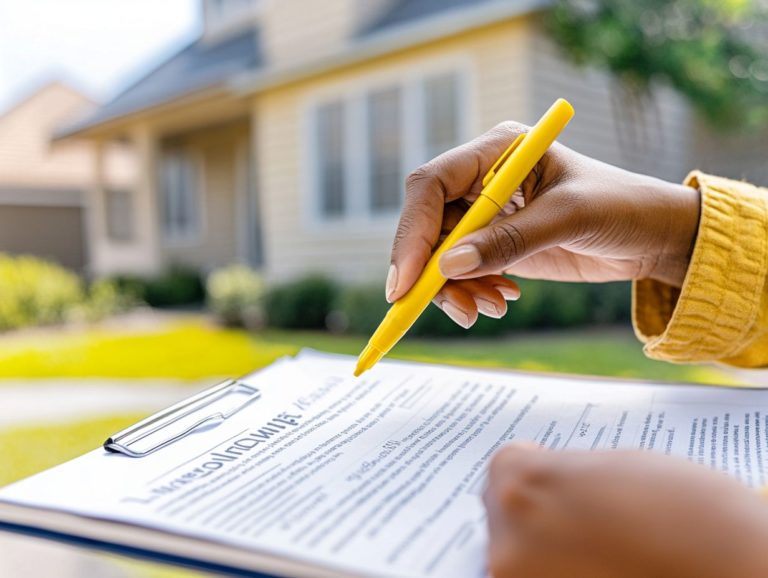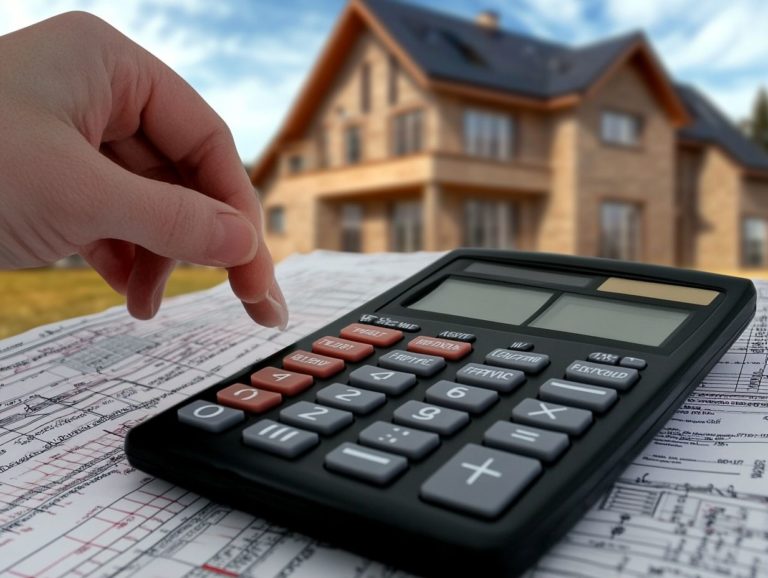How Home Insurance Providers Calculate Premiums
Home insurance is crucial for safeguarding your investment. However, unraveling the complexities of how premiums are calculated can be a challenge.
This article will clarify the essential elements of home insurance premiums, detailing what they entail and the various factors that influence their cost. From the location of your property to your claims history, every component contributes to determining your premium.
You ll discover methods for calculating premiums and gain practical strategies to lower your costs. Additionally, you can compare providers to find the perfect fit for your needs.
Are you ready to navigate the intricacies of home insurance? Let s explore this together for a smooth journey!
Contents
- Key Takeaways:
- Understanding Home Insurance Premiums
- Factors that Affect Home Insurance Premiums
- Calculating Home Insurance Premiums
- Ways to Lower Home Insurance Premiums
- Comparing Home Insurance Providers
- Frequently Asked Questions
- 1. What factors do home insurance providers consider when calculating premiums?
- 2. How does the location of my home affect my insurance premium?
- 3. Does the age of my home affect my insurance premium?
- 4. How can my claims history affect my insurance premium?
- 5. Does the type of coverage I choose impact my insurance premium?
- 6. Can I lower my insurance premium?
- Lowering Your Insurance Premium
- Impact of Home Age on Insurance Costs
- Claims History and Premiums
- Coverage Type Matters
Key Takeaways:

- Home insurance premiums are the cost of coverage for your home and belongings.
- Location, property characteristics, claims history, and credit score can impact your premium.
- Providers use various methods to calculate premiums, and you can lower them by utilizing strategies such as bundling policies and improving home security.
Understanding Home Insurance Premiums
Understanding home insurance premiums is vital for homeowners like you who want to protect your assets. Specifically, the impact of claims on your home insurance premium plays a significant role in determining the affordability and accessibility of various insurance options available to you.
It s important to evaluate average rates based on specific factors such as dwelling coverage, liability coverage, and any additional coverage you may need to protect against property damage or liability claims.
With a multitude of insurance policies on the market, knowing how these premiums are calculated and what influences them is essential. This knowledge enables you to make informed financial decisions about home insurance and helps you understand home insurance providers’ terminology to find the best coverage tailored to your unique needs.
What are Home Insurance Premiums?
Home insurance premiums are the amounts you pay, typically on an annual basis, to keep your property and personal assets covered against various risks.
These premiums are essential to the structure of home insurance policies, ensuring that you are financially protected from unexpected events like fire, theft, or natural disasters.
The specific costs of these premiums can vary widely based on several factors, including the coverage limits you choose. Coverage limits are the maximum amounts your insurance will pay for a claim, determining how much protection you have for your home and belongings.
Generally, higher coverage limits lead to elevated premiums, reflecting the increased risk the insurance provider takes on. This dynamic highlights the importance of selecting appropriate coverage limits. It significantly impacts not only your monthly expenses but also your peace of mind, knowing your investments are adequately protected.
Factors that Affect Home Insurance Premiums
Several factors significantly influence your home insurance premiums, including your location and the characteristics of your property.
It’s crucial for you to understand how these elements can affect your overall insurance costs.
Location and Property Characteristics
The location of your home plays a crucial role in determining your insurance premiums. Properties situated in high-risk areas often face elevated costs, primarily due to the increased likelihood of property damage or liability claims.
In urban environments, where crime rates and environmental hazards tend to be higher, you can expect to pay more than in rural areas, where lower population density generally means fewer risks.
Specific characteristics of your property also influence your rates. For instance, homes built with fire-resistant materials or reinforced structures may see favorable adjustments.
If your home boasts advanced security features like alarms or surveillance systems, you could enjoy reduced premiums, as these elements lower the risk for insurers.
By understanding the connection between geographic location and unique property attributes, you can make informed decisions that might ultimately lead to savings on your insurance.
Start comparing insurance options today!
Claims History and Credit Score
A homeowner’s claims history and credit score play an important part in shaping insurance premiums. Insurers rely on these factors to assess risk and anticipate potential future claims.
When evaluating an insurance application, companies meticulously review prior claims as key indicators of risk. If you have a history of frequent claims, your premiums are likely to rise. Your credit score is also scrutinized, reflecting your financial responsibility. A lower credit score can signal to insurers that you might be more likely to file future claims, resulting in higher rates.
This intricate relationship between claims history and creditworthiness during the underwriting process underscores the significance of presenting both factors favorably. This can help secure more competitive insurance pricing.
By grasping this connection, homeowners can take proactive measures to manage their risk profiles effectively.
Calculating Home Insurance Premiums

Calculating your home insurance premiums involves understanding what factors affect home insurance premiums and the various sophisticated methodologies utilized by insurance companies.
They carefully consider many factors, including average rates, types of coverage, and specific policy details. All of this is to determine an accurate premium figure tailored just for you.
Methods Used by Providers
Insurance providers use various methods to calculate premiums. They focus on underwriting criteria and risk assessments to create tailored insurance products for homeowners, including understanding how home insurance providers handle claims.
Using actuarial analysis (a method that uses statistics to predict risks), they sift through statistical data to predict potential losses and adjust premiums accordingly.
Market comparisons are also crucial; insurers examine similar policies in the market to ensure their rates are competitive while reflecting the unique challenges you might face.
This multifaceted approach enables them to fine-tune their offerings, striking a balance between affordability for you and profitability for the company. Ultimately, this results in a fair premium that accurately captures your individual risk profile.
Ways to Lower Home Insurance Premiums
Homeowners have several strategies at their disposal to reduce their home insurance premiums effectively.
By exploring different insurance options, qualifying for various discounts, and adjusting coverage types to better align with their financial needs, they can achieve significant savings.
Strategies to Reduce Costs
Implementing effective strategies to reduce your home insurance costs can be quite rewarding. Consider negotiating custom quotes and adjusting coverage limits for high-value items, and take full advantage of any available discounts.
You might also want to explore bundling your policies. Many insurers offer enticing discounts when you combine home and auto insurance, which can significantly lower your premiums.
Increasing your deductibles can lead to substantial monthly savings. However, be sure to set a deductible that remains manageable should you need to file a claim.
Make it a habit to regularly review and update your inventory of personal possessions, particularly high-value items like jewelry or electronics. This approach allows you to tailor your coverage accurately, ensuring you re only paying for what you truly need and avoiding unnecessary expenses.
Don t wait! Implementing these strategies now can lead to significant savings on your home insurance.
Comparing Home Insurance Providers
Comparing home insurance providers is crucial for homeowners like you who seek the best rates and coverage options.
This process allows you to evaluate various insurance products and quoting details, empowering you to make well-informed decisions tailored to your specific needs.
How to Find the Best Premium for Your Needs
Finding the best premium for your homeowners insurance requires a deep dive into various options.
Collect quote information from multiple providers to secure comprehensive coverage at a competitive rate.
Start by using online comparison tools to assess premiums quickly. Just make sure to input accurate details about your home and its features.
Next, consider reaching out to various insurance agents who can provide personalized insights and help you navigate the complexities of the coverage options available. Evaluate what s included in each policy, such as:
- The amount needed to replace your home versus its current value
- Additional living expenses
- Liability coverage, which protects you in case someone is injured on your property
These factors can greatly influence your premiums and the value of your homeowners insurance. Pay close attention to them!
Frequently Asked Questions

Home insurance providers consider a variety of factors when calculating premiums, including the location and age of the home, the size and type of the home, the homeowner’s claims history, and the level of coverage desired by the homeowner. For more insights, check out understanding home insurance providers’ policy changes.
The location of your home plays a significant role in determining your insurance premium. If your home is located in an area prone to natural disasters, such as hurricanes or earthquakes, your premium may be higher due to the increased risk of damage. Similarly, living in a high-crime area may also result in a higher premium.
Yes, the age of your home can impact your insurance premium. Older homes may have outdated plumbing, electrical, or structural systems that can increase the risk of damage. As a result, insurance providers may charge a higher premium to cover these potential risks.
If you have a history of filing multiple insurance claims, your premium may be higher. This is because insurance providers view frequent claims as a sign of potential risk and may charge a higher premium to offset this risk.
Yes, the type of coverage you choose can affect your insurance premium. For example, if you opt for a higher level of coverage, such as additional liability protection, your premium may be higher to account for the increased risk and potential costs for the insurance provider.
Lowering Your Insurance Premium
Yes, there are several ways to lower your insurance premium. Consider increasing your deductible, which is the amount you pay out of pocket before your insurance starts to help. Improving safety features or bundling your home insurance with other policies from the same provider can also be effective strategies.
It’s a good idea to regularly review your coverage to ensure you aren t overpaying.
Impact of Home Age on Insurance Costs
The age of your home can affect your insurance premium. Older homes may have outdated systems that increase the risk of damage, which can lead to higher premiums.
Claims History and Premiums
Your claims history can influence your premium. If you have a history of multiple claims, insurance providers may see you as a higher risk and increase your rate accordingly.
Coverage Type Matters
The type of coverage you choose impacts your premium. Opting for higher coverage, such as additional liability protection, may raise your costs.







